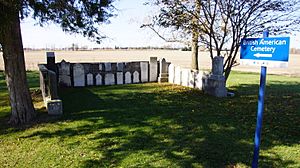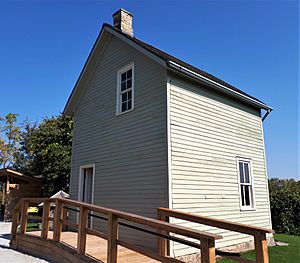Josiah Henson Museum of African-Canadian History facts for kids
| Musée Josiah Henson l'histoire des Afro-Canadiens | |
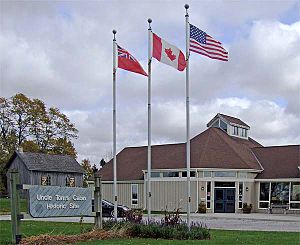
Visitor centre for Josiah Henson Museum of African-Canadian History
|
|
| Established | 1964 |
|---|---|
| Location | 29251 Freedom Road, Dresden, Ontario, Canada |
| Type | Open air museum |
| Owner | Ontario Heritage Trust |
| Official name: Josiah Henson Museum of African-Canadian History | |
| Designated: | 6 April 2005 |
The Josiah Henson Museum of African-Canadian History is a special open-air museum in Dresden, Ontario, Canada. It tells the story of Josiah Henson, a brave man who escaped slavery. The museum also teaches about the history of slavery and the Underground Railroad, a secret network that helped enslaved people find freedom.
This important place is built on the land of the old Dawn settlement. Josiah Henson, who was a person who escaped slavery, a fighter against slavery, and a minister, started this community. His life story, written in his autobiography, helped inspire the main character in the famous book Uncle Tom's Cabin by Harriet Beecher Stowe.
The museum covers about 2 hectares (5 acres). It has a visitor centre, several old buildings from the Dawn settlement, and two cemeteries. One of these cemeteries is where Josiah Henson is buried. People started taking informal tours of Henson's family home in 1948. The whole property became a museum in 1964. It was first called Uncle Tom's Cabin Historic Site. The museum was privately owned until 1988, then it was sold to Kent County. Later, in 2005, the Ontario Heritage Trust took over its ownership.
Contents
The Story of the Museum and Settlement
The museum stands on the land of the Dawn settlement. This community was started by Josiah Henson, a Methodist preacher. He was a person who escaped slavery and found freedom in Canada on October 28, 1830. Henson often returned to the United States. He helped many other enslaved people escape to Canada as a "conductor" on the Underground Railroad. It's believed he personally guided 118 people to freedom. Henson also led a Black Canadian Militia unit as a captain during the Rebellions of 1837–1838.
The Dawn Settlement Community
The Dawn settlement began in 1841, a few years after the rebellion. Henson bought 200 acres (81 hectares) of land. This land became a safe place and a workplace for people who had escaped slavery from the United States. The settlement grew crops and harvested eastern black walnut wood. This wood was then sold to places like the United Kingdom and the United States.
In 1842, Henson helped create the British-American Institute in Dawn. This school taught settlers useful job skills. A sawmill was also built in the settlement. The products from this sawmill even won Henson a medal at the Great Exhibition in London.
Josiah Henson's Famous Story
In 1849, Josiah Henson published his life story, called The Life of Josiah Henson, Formerly a Slave, Now an Inhabitant of Canada, as Narrated by Himself. This book caught the attention of people who wanted to end slavery. His autobiography later inspired the main character in Harriet Beecher Stowe's famous anti-slavery novel, Uncle Tom's Cabin.
When Uncle Tom's Cabin first came out, some people who supported slavery in America said it wasn't true. Harriet Beecher Stowe then wrote another book, A Key to Uncle Tom's Cabin. In this book, she explained her sources. She said she was inspired by the "published memoirs of the venerable Josiah Henson."
At its busiest, about 500 settlers lived in Dawn. After the Emancipation Proclamation in 1862, which declared many enslaved people free, some settlers returned to the United States. During the American Civil War, Henson supported families whose men went back to fight. The settlement slowly declined after the British-American Institute closed in 1868. Many remaining settlers moved to other towns in Ontario.
However, Josiah Henson stayed at the settlement until he passed away in 1883. He was buried near his home. His funeral was one of the largest ever held in Dresden. Businesses closed, and a 2 kilometre (1.2 mile) procession followed to his gravesite. After Henson's death, his wife sold their home and moved to Michigan.
After the Settlement Ended
After Henson's wife sold the house, it was left empty for a while. In the 1920s, Black Freemasons, a group Henson joined later in life, started visiting the house. In 1930, members of the Imperial Order Daughters of the Empire (IODE) began looking after the gravesites. The Dresden & District Horticultural Society joined them the next year. In 1933, the horticultural society officially took over caring for the gravesite.
How the Museum Started
William Chapple, who owned the land around Henson's home, saw it as a possible place for tourists. He opened the house to the public in 1948. Chapple even wrote a book, The Story of Uncle Tom, to promote the building and gave tours. Visitors would leave donations in a pot outside the house.
Chapple later sold his property to Jack Thomson. During Thomson's ownership, the Henson home was moved twice. Thomson then opened the entire property as a museum in 1964. Soon after, he asked Barbara Carter, a descendant of Henson, to be the museum's curator. Carter helped the museum expand its focus. It no longer just told Henson's story, but also included the wider history of slavery and the Underground Railroad.
In 1984, Kent County bought the property and ran the museum. In 1995, the St. Clair Parkway Commission took over. A big restoration project, costing C$1.2 million, happened that year. Buildings were restored to look like they did in the past, and a new visitor centre was built. In 1999, the Historic Sites and Monuments Board of Canada placed a plaque near Henson's grave. It recognized him as a "Canadian of National Historic Significance."
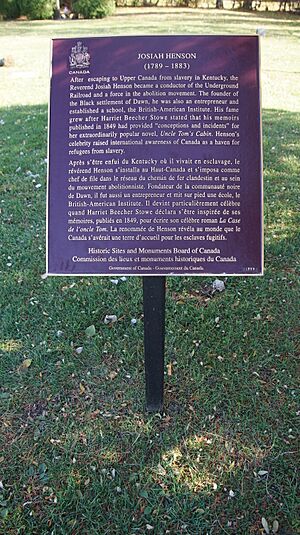
In 2005, the Ontario Heritage Trust became the owner. This is an agency of Ontario's Ministry of Heritage, Sport, Tourism and Culture Industries. In the same year, three historic buildings on the property were recognized as heritage buildings under the provincial Ontario Heritage Act.
In the 2010s, the museum thought about changing its name. They wanted to use Henson's real name and avoid the negative "Uncle Tom" nickname that came from old minstrel shows. In July 2022, the museum officially changed its name from Uncle Tom's Cabin Historic Site to the Josiah Henson Museum of African-Canadian History.
Exploring the Museum Grounds
The museum is located in southwest Dresden, close to the Sydenham River. It's an open-air museum on 5 acres (2 hectares) of land. This land once held the British-American Institute of the Dawn settlement.
The property has a visitor centre built in 1994. Inside, you'll find the North Star Theatre, the Underground Railroad Freedom Gallery, and a gift shop. The theatre usually shows a video about Henson's life. The gallery displays items related to the Dawn settlement, Henson's life, and the Underground Railroad. The museum's collection includes an early copy of his autobiography.
Two cemeteries are on the site. One is for the British-American Institute, and the other is the Henson family cemetery. Only 21 gravestones are visible in the Henson family cemetery, but it's believed more than 300 graves are there. A special monument for Henson is near his grave. It has a Masonic symbol and a crown, showing his visit with Queen Victoria.
Besides the visitor centre and gravesites, there are several historic buildings. These include three buildings recognized by the Ontario Heritage Act, a sawmill, and a smokehouse.
Historic Buildings to See
There are three historic buildings at the Josiah Henson Museum that are recognized under the Ontario Heritage Act. All of them are from the 1800s. Two of these old homes belonged to people who lived in the Dawn settlement. The Pioneer Church is another historic building that was moved to the museum site.
The Henson family home is a good example of a typical 19th-century house. It's a two-story building made of wood, with a post-and-beam frame and clapboard siding. The house was built using local materials like red oak. The building was moved several times after the Henson family left, but it always stayed within the original Dawn settlement area. The exact age of the Henson home is hard to know for sure. Experts think it was built around 1850. In 1995, the building was restored to look like it did in the 1850s.
The Harris House is another historic two-story, wood-sided building on the property. It was built in 1890 and originally stood in a different part of Dresden. After its first owners left, it was used to store grain on a nearby farm. In 1964, it was moved to the museum to help with its operations. This house shows a common style built by Black refugees arriving in Canada during that time. It was designed to keep people warm in winter, with a taller structure to make the most of heat from the fireplace.
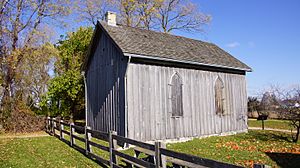
The third historic building is the Pioneer Church. It's a one-room, single-story wooden building with a Carpenter Gothic style. This style was common for churches in rural Ontario back then. Although the Pioneer Church dates back to the 1850s, it wasn't built by the Dawn settlers. It was originally located 70 kilometres (43 miles) away in Wheatley, Ontario. It served as both an Anglican and Presbyterian church.
The Pioneer Church was moved to the museum in the 1960s. It was chosen because it looked very similar to the original church in the Dawn settlement, which was destroyed by fire in the early 1900s. Two items from the original Dawn church were saved and placed in the Pioneer Church: an oak pulpit and an organ.
Other Places to Learn From
- Buxton National Historic Site and Museum
- Chatham Vigilance Committee
- John Freeman Walls Historic Site
- List of museums in Ontario
- Queen's Bush


